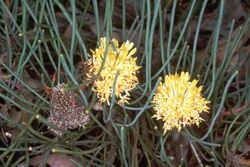Biology:Petrophile media
| Petrophile media | |
|---|---|

| |
| In the Australian National Botanic Gardens | |
| Scientific classification | |
| Kingdom: | Plantae |
| Clade: | Tracheophytes |
| Clade: | Angiosperms |
| Clade: | Eudicots |
| Order: | Proteales |
| Family: | Proteaceae |
| Genus: | Petrophile |
| Species: | P. media
|
| Binomial name | |
| Petrophile media R.Br.[1]
| |
| Synonyms[1] | |
| |
Petrophile media is a species of flowering plant in the family Proteaceae and is endemic to southwestern Western Australia. It is a low, spreading to erect shrub with needle-shaped leaves, and oval heads of hairy cream-coloured to yellow flowers.
Description
Petrophile media is a low spreading to erect shrub that typically grows to a height of 0.5–0.8 m (1 ft 8 in–2 ft 7 in) and has glabrous branchlets and leaves. The leaves are needle-shaped, up to 300 mm (12 in) long, sometimes with a short, curved tip. The flowers are arranged on the ends of branchlets in sessile, oval heads about 25 mm (0.98 in) long, with many tapering, linear to lance-shaped involucral bracts at the base. The flowers are about 15–20 mm (0.59–0.79 in) long, cream-coloured to yellow and hairy. Flowering occurs from August to February and the fruit is a nut, fused with others, usually in an oval head 10–25 mm (0.39–0.98 in) long.[2][3]
Taxonomy
Petrophile media was first formally described in 1830 by Robert Brown in the Supplementum to his Prodromus Florae Novae Hollandiae et Insulae Van Diemen from material collected by William Baxter near King Georges Sound in 1829.[4][5] The specific epithet (media) means "middle" , "common" or "intermediate between other species".[6]
Distribution and habitat
Petrophile media grows in a variety of habitats on the Darling Range south of Perth and on the coastal plain to the Stirling Range and eastwards to near Ravensthorpe in the Avon Wheatbelt, Esperance Plains, Jarrah Forest and Mallee biogeographic regions.[2][3]
Conservation status
This petrophile is classified as "not threatened" by the Western Australian Government Department of Parks and Wildlife.[3]
References
- ↑ 1.0 1.1 "Petrophile media". Australian Plant Census. https://biodiversity.org.au/nsl/services/apc-format/display/60355.
- ↑ 2.0 2.1 Foreman, David B.. "Petrophile media". Australian Biological Resources Study, Department of Agriculture, Water and the Environment: Canberra. https://profiles.ala.org.au/opus/foa/profile/Petrophile%20media.
- ↑ 3.0 3.1 3.2 "Petrophile media". FloraBase. Western Australian Government Department of Parks and Wildlife. https://florabase.dpaw.wa.gov.au/browse/profile/2302.
- ↑ "Petrophile media". APNI. https://id.biodiversity.org.au/instance/apni/465367.
- ↑ Brown, Robert (1830). Supplementum primum prodromi florae Novae Hollandiae. London. p. 5. https://www.biodiversitylibrary.org/item/77294#page/518/mode/1up. Retrieved 17 December 2020.
- ↑ Sharr, Francis Aubi; George, Alex (2019). Western Australian Plant Names and Their Meanings (3rd ed.). Kardinya, WA: Four Gables Press. p. 250. ISBN 9780958034180.
Wikidata ☰ Q18075553 entry
 |

